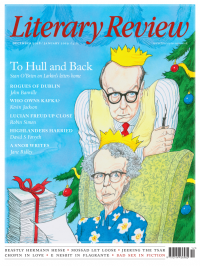Jeremy Noel-Tod
Chapter & Verse
The Poem: Lyric, Sign, Metre
By Don Paterson
Faber & Faber 732pp £25
There has always been something of the don about Don Paterson. Although he left school at sixteen, his first book of poems, Nil Nil (1993), published at the age of thirty, was evidently the work of a polymathic imagination. ‘The Alexandrian Library’, a darkly witty dream sequence, resurrects that lost store of ancient literature as a second-hand bookshop purveying such rarities as ‘the Bible/they quietly pulped when the proof-reader’s shopping list/turned up in Numbers’, an enormous book of Latin riddles composed as a ‘triple acrostic’ and The Epic of Gilgamesh ‘edited down/to the original camping-weekend’.
Twenty-five years later, the poet who conjured these bravura absurdities has produced a 750-page ars poetica that is surely itself doomed to become a regular on the shelves of charity shops. Now a professor of poetry at St Andrews and poetry editor at Picador (not to mention a double winner of the T S Eliot Prize for Poetry), Paterson has authority to spare. He has chosen to invest it in The Poem: Lyric, Sign, Metre, an eloquent and learned triple-decker discussion of poetic language (‘Lyric’), trope (‘Sign’) and rhythm (‘Metre’). What’s impressive about the book is how sincerely it wishes to initiate us into the nuts and voltas of ‘a decent poem’ – as Wyndham Lewis once said of Ezra Pound, ‘he would teach anybody to be Dante, technically’. What’s dismaying is how many kinds of poem and poet get left outside the lecture hall.
Put simply, it’s astonishing that a grand unified theory of poetry published in 2018 has been predominantly illustrated with the words of white male poets. Paterson’s examples, mainly drawn from his elders and contemporaries in British, Irish and American verse, presumably represent some kind of personal anthology. But

Sign Up to our newsletter
Receive free articles, highlights from the archive, news, details of prizes, and much more.@Lit_Review
Follow Literary Review on Twitter
Twitter Feed
It wasn’t until 1825 that Pepys’s diary became available for the first time. How it was eventually decrypted and published is a story of subterfuge and duplicity.
Kate Loveman tells the tale.
Kate Loveman - Publishing Pepys
Kate Loveman: Publishing Pepys
literaryreview.co.uk
Arthur Christopher Benson was a pillar of the Edwardian establishment. He was supremely well connected. As his newly published diaries reveal, he was also riotously indiscreet.
Piers Brendon compares Benson’s journals to others from the 20th century.
Piers Brendon - Land of Dopes & Tories
Piers Brendon: Land of Dopes & Tories - The Benson Diaries: Selections from the Diary of Arthur Christopher Benson by Eamon Duffy & Ronald Hyam (edd)
literaryreview.co.uk
Of the siblings Gwen and Augustus John, it is Augustus who has commanded most attention from collectors and connoisseurs.
Was he really the finer artist, asks Tanya Harrod, or is it time Gwen emerged from her brother’s shadow?
Tanya Harrod - Cut from the Same Canvas
Tanya Harrod: Cut from the Same Canvas - Artists, Siblings, Visionaries: The Lives and Loves of Gwen and Augustus John by Judith Mackrell
literaryreview.co.uk